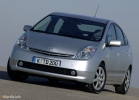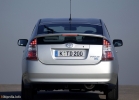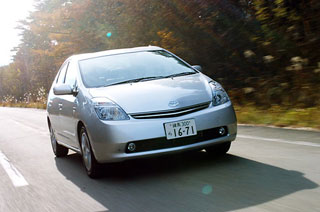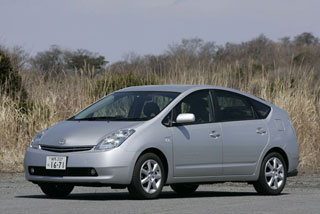Toyota Prius 2006 test drive - 2008 hatchback
We test the best hybrid in the world
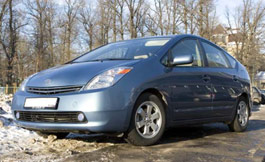 Hybridization walks along the smoky globe, hidden by servo drives and moaning by electric motor. Perhaps in the future, as in a fantastic film, I am a robot, people will be horrified to look at the internal combustion engines. But while the first messengers of the new era are just beginning to implant various systems that lower fuel consumption and improve the quality of the exhaust. STOP-AD-go systems, multi-stage neutralizers, a depleted mixture is already used on BMW, Citroen, and on many other brands. But even among these advanced Toyota Prius Hybrid cars, it stands apart. It was this car that was originally designed as a hybrid, and is not an alteration of the original original. And it was he who in 1997 was the first in the now rapidly growing segment of cars with a combined power plant. And still Toyota Prius remains the most environmentally friendly car in the world.
Hybridization walks along the smoky globe, hidden by servo drives and moaning by electric motor. Perhaps in the future, as in a fantastic film, I am a robot, people will be horrified to look at the internal combustion engines. But while the first messengers of the new era are just beginning to implant various systems that lower fuel consumption and improve the quality of the exhaust. STOP-AD-go systems, multi-stage neutralizers, a depleted mixture is already used on BMW, Citroen, and on many other brands. But even among these advanced Toyota Prius Hybrid cars, it stands apart. It was this car that was originally designed as a hybrid, and is not an alteration of the original original. And it was he who in 1997 was the first in the now rapidly growing segment of cars with a combined power plant. And still Toyota Prius remains the most environmentally friendly car in the world. From a distance, it is difficult to understand which class to attribute the car to. Either a small minivan, or a large hatchback. If you look at Prius strictly in the profile, the unusual shape of the roof and the lifetime of the body pays attention. And this is not surprising. The car, at the forefront of which is economical, is simply obliged to possess aerodynamics close to the ideal. They say that when designing Prius, the Japanese caught a large fish called a silver carp. And it was she who became the prototype of Prius. Large front headlights swimming on the hood, crystal rear optics, broken rear window, the performance of which is ideologically close to Citroen C4, even after three years on the conveyor they look quite non -trivial, which once again refutes the statement with a good CX similar to each other.
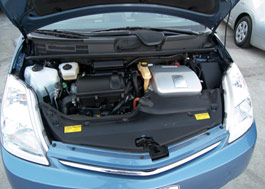 Approaching the car, holding out my hand to the door, and Prius clicks with opened locks. The built -in sensor felt the approach of a person, sent a request for the presence of a contactless key to him, and, having received a positive answer, helpfully unlocked the locks. This is how the Keyless-Go system works. To close the car, you also do not need to get the keys - just touch the button on the door.
Approaching the car, holding out my hand to the door, and Prius clicks with opened locks. The built -in sensor felt the approach of a person, sent a request for the presence of a contactless key to him, and, having received a positive answer, helpfully unlocked the locks. This is how the Keyless-Go system works. To close the car, you also do not need to get the keys - just touch the button on the door. At the very beginning, it seemed to us that the salon of a car formally related to class C would not hit the expanse. But the minivan body architecture played a role. Behind the place is not just enough. There are a lot of it. Although we managed to find one drawback. If the growth of the passenger is above 190 cm, then his crown rests on the ceiling - to please the aerodynamics, engineers excessively overwhelmed the rear racks. Since 2006, this problem has been eliminated by changing the shape of the rear sofa pillow. Access to the trunk is convenient, but the space itself could be larger. The fact is that it is behind the back row of chairs, under the floor that the battery, which ensures the life of the entire system, is hidden.
The car interior, like its ideology itself, is non -standard. The speedometer, the odometer, the indicator of the fuel level and the gearbox mode are displayed before the driver's eyes under the very edge of the windshield. Planting behind the wheel is generally quite unusual and not very comfortable seat installed high, and the steering wheel is located low. Even adjustment on the angle of inclination does not help - it still seems that you are sitting too high. Having taken behind the wheel, for some time I could not understand what was wrong with him. Abundance of control buttons on it? No, this is not so new, there were cars with a large number of buttons. Silver inserts? Also no. And only twisting the steering wheel from side to side, I understood! Firstly, the steering wheel is small. The electrical power has nullified the need for a large shoulder. And secondly, the steering wheel itself is not perfectly round, but rather elliptical, flattened from above and below. That is why it seems that you are sitting behind a computer steering wheel simulator.
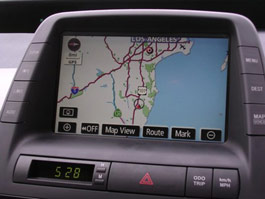 The heart of the interior is a greater Touch-Screen monitor, which displays almost all useful information. The navigation system is still useless - Toyota is in no hurry with the release of Russian cards. But the built -in Bluetooth allows you to attach your phone to the car by freed your hands. And the top for Prius JBL system has a very powerful and pure sound. A large number of diverse messages, cup holders and pockets are quite explained by the fact that the car was created with an eye on the American market.
The heart of the interior is a greater Touch-Screen monitor, which displays almost all useful information. The navigation system is still useless - Toyota is in no hurry with the release of Russian cards. But the built -in Bluetooth allows you to attach your phone to the car by freed your hands. And the top for Prius JBL system has a very powerful and pure sound. A large number of diverse messages, cup holders and pockets are quite explained by the fact that the car was created with an eye on the American market. So, I click the large Voyototovskaya engine start button (the key does not need to be inserted anywhere, it is lying somewhere in your pocket). On the scoreboard under the glass the inscription Ready lights up and nothing happens. The starter does not grunt, does not coil in an attempt to align the idle speed of the engine. Nothing! Maybe I forgot something to turn on, maybe the clumsy scabble should be squeezed? No, just Prius is ready to go. For this, a simple charge is enough in the battery. Transferring the little joystick (hello from computer scientists again) to the Drive position, I smoothly press the gas pedal. Quietly rustling Toyota tires leaves the parking lot. Surprised drivers with open mouths watch how the car went silently from the yard. If you do not press the slipper on the floor, then on one electric protrusion you can accelerate to 60 km/h.
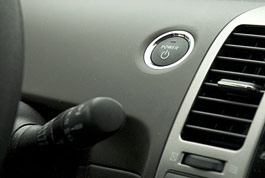 The most interesting thing in Prius is a sense of competition. But these races contradict all the street-racer rules. After all, we are not won the fastest, but the most rational. A large monitor in the mode of displaying the economy of movement displays information about the efficiency of the use of fuel liters, splashing in the tank and the route of energy distribution between the battery, brakes, internal combustion engine and electric motor. So I drive up to the traffic light. I release the gas, the engine instantly turns off, and Prius is approaching the intersection. At the same time, recovery mechanisms generate energy that the car uses for subsequent acceleration. Green arrows of indication on the monitor run from the brake mechanisms to the battery, as if saturating it. I stop at the feet of the line. Red light promises to be long, so you can poke the POTOSTO POLOSK, conveniently located above the joystick of the box. A kind of Parking-Light mode allows you not to keep the leg on the brake pedals. Standing at a traffic light, the internal combustion engine does not waste gasoline from the tank, does not spit into the atmosphere with minimal, but still exhaust. Prius is located in the electric car. At the same time, the picture on the display freezes, confirming that the energy for the headlights, music and air conditioning is taken from the battery.
The most interesting thing in Prius is a sense of competition. But these races contradict all the street-racer rules. After all, we are not won the fastest, but the most rational. A large monitor in the mode of displaying the economy of movement displays information about the efficiency of the use of fuel liters, splashing in the tank and the route of energy distribution between the battery, brakes, internal combustion engine and electric motor. So I drive up to the traffic light. I release the gas, the engine instantly turns off, and Prius is approaching the intersection. At the same time, recovery mechanisms generate energy that the car uses for subsequent acceleration. Green arrows of indication on the monitor run from the brake mechanisms to the battery, as if saturating it. I stop at the feet of the line. Red light promises to be long, so you can poke the POTOSTO POLOSK, conveniently located above the joystick of the box. A kind of Parking-Light mode allows you not to keep the leg on the brake pedals. Standing at a traffic light, the internal combustion engine does not waste gasoline from the tank, does not spit into the atmosphere with minimal, but still exhaust. Prius is located in the electric car. At the same time, the picture on the display freezes, confirming that the energy for the headlights, music and air conditioning is taken from the battery. But the green light lights up, pumping the joystick in the Drive position, I smoothly press the gas. Yellow arrows on the monitor ran from the battery to the front wheels. Remember the energy that has developed during braking? It is she who is now pushing the car forward. 10 km/h, 30, 50, 60 km/h, the engine started up, red arrows ran from ICE to the front wheels, helping the electric motor cope with the growing air resistance, and to the battery, recharging it. But you just have to loosen the pressure on the gas pedals, the internal combustion engine immediately turns off, allowing the work only to the electric motor. Moreover, the fact of turning on and off the engine for the driver is completely invisible, it can only be found out by changing the indicator on the monitor.
At the next traffic light to the left of me, abruptly pecking his nose, Saab stops. Not Aero, of course, but still rushing into battle. It would seem that it can contrast him with a 1.5-liter motor with a capacity of 76 hp? But do not forget that this is only half of the energy weapons. The electric motor adds another 67 hp, and its peak power is available from the very beginning of the movement. Green. It’s good that under the wheels dry asphalt. Otherwise, an avalanche of the moment of 440 Nm would make the APS work. Propaging at the maximum engine speed, Prius with completely unexpected power accelerates from the traffic light. And while the Saab driver spun the engine, Prius already managed to play several meters, and, continuing to accelerate powerfully, was the leader up to 120 km/h. Then a more powerful Swedish apparatus caught up with Toyota and slowly walked around it. After 140 km/h, the dynamics of acceleration in Prius fell noticeably, and the limiter worked 175 km/h. Well, not bad for a car with a motor of 1.5 liters. Not bad at all.
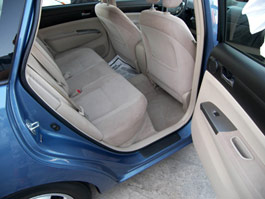 Prius does not have sufficient sound insulation, although in the case of a hybrid, this is explainable by the desire to reduce weight as much as possible. The situation exacerbates, oddly enough, the lack of motor noise. Without the sound of the motor, rustling tires, the whistle of wind and the fraction of the road sand on the shelter subjectively seem louder. And if you press the gas on the floor, then the engine will quarrel, demonstrating the variator essence of the box. Having hung on a high note, the sound is similar to the cooler on the computer - just as monotonously and completely unauthorized. Accustomed to mechanical boxes of drivers, this may seem unusual. In addition, in the box there are no often used by other manufacturers of tricks, such as fixed positions of the variator that simulate speed switching.
Prius does not have sufficient sound insulation, although in the case of a hybrid, this is explainable by the desire to reduce weight as much as possible. The situation exacerbates, oddly enough, the lack of motor noise. Without the sound of the motor, rustling tires, the whistle of wind and the fraction of the road sand on the shelter subjectively seem louder. And if you press the gas on the floor, then the engine will quarrel, demonstrating the variator essence of the box. Having hung on a high note, the sound is similar to the cooler on the computer - just as monotonously and completely unauthorized. Accustomed to mechanical boxes of drivers, this may seem unusual. In addition, in the box there are no often used by other manufacturers of tricks, such as fixed positions of the variator that simulate speed switching. During the test, the effective use of energy made it possible to achieve tangible performance indicators. In the most dull traffic jams, Prius did not consume more than 7 liters per 100 km, and smoothly moving around the evening city at an average speed of about 60 km/h, the consumption decreased to 4 liters. So what? - you ask. The same VW Polo with a diesel engine eats 3.5 liters per hundred. Yes, this is so, but the irony is that Prius is a large family car, the size of which is incomparably larger. And besides, the highlight remains that at any moment Prius can move from an economical regime to the forced, using the entire power of two engines.
In the management, the car leaves the impression of compilation of non -standard solutions. A small steering wheel has a very sharp characteristic. At the same time, the feedback is practically absent, which is why the similarity with a sports computer simulator is further enhanced. The suspension of Prius is quite dense to painlessly perform sharp restructures, and at the same time amazingly energy intensive. Crown number moves of bedridden police officers. The car will smoothly swallow unevenness, like a limousine pair of classes higher. But with small road joints and dimples, everything is not so good. Small trash can be felt on the steering wheel.
Most likely, it was the battery in the stern that favorably affected the weight. The Prius turn is very confident, firmly tracking the trajectory. If you come closer to the maximum speed, the car begins to smoothly go into the demolition of the front axle. Of course, except for a very sharp steering wheel, there is no sports to the car in the car. But, apparently, the creators did not set this task. Rather, on the contrary, the goal was the maximum reliability of management and the understandability of reactions.
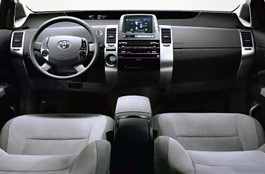 At high speed, Prius also behaves very stable. Unless narrow tires react more acutely to rut, but in general the car holds straight, gently swaying on long waves.
At high speed, Prius also behaves very stable. Unless narrow tires react more acutely to rut, but in general the car holds straight, gently swaying on long waves. So what is Toyota Prius? A newcomer from the future? Super -technical hybrid system, design, interior, electronics and ideology say yes. But with all this, Prius remains an ordinary car that is practically in no way inferior to their classmates in terms of convenience of use. Yes, in many ways it does not look like ordinary cars, which will undoubtedly scare off conservative customers. But this is our future. Whether we want it or not. And, probably, the fact that instead of fashion for powerful voracious multi -liter cars comes the fashion for reasonable environmentally friendly and self -sufficient hybrids. And the queue of several months for the new Prius in the USA is only confirmation.
A little about the service
One of the main questions asked by passers -by was the question of the maintainability of the car. Yes, so far Toyota Prius is not officially delivered to Russia, but at least several services specializing in hybrid cars are already operating in Moscow. Well, if you want to go to the officials, then the hybrid Lexus supplied to us possess the same technologies, and dealers usually do not refuse to conduct maintenance. In general, the reliability of Prius can be talked quite definitely. The right -handed Prius of the first generation wrapped more than one hundred thousand kilometers along our roads. And as for hybrid technologies, as the servicemen say, they are extremely reliable. The batteries do not die with their death, they are usually killed by improper operation. In frosts, a hybrid car starts an order of magnitude better than its usual counterparts.
History Prius
Although car sellers stubbornly say that Prius II is now being produced, this is actually the third generation of a hybrid car. The fact is that
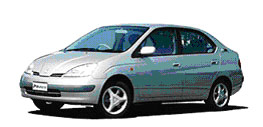 Toyota Prius of the first generation (NHW10), the world's first serial car with a hybrid engine, was sold exclusively in the Japanese market. The model blew up the market, even despite its mediocre design. And although buyers around the world showed interest in Toyota Prius, the Japanese company decided to roll up technology at home. It was this principle that not to produce raw cars to foreign markets that allowed Toyota to head the list of automobile companies. In total, 70,000 Toyota Prius was released. A small part of them was withdrawn due to problems with the battery.
Toyota Prius of the first generation (NHW10), the world's first serial car with a hybrid engine, was sold exclusively in the Japanese market. The model blew up the market, even despite its mediocre design. And although buyers around the world showed interest in Toyota Prius, the Japanese company decided to roll up technology at home. It was this principle that not to produce raw cars to foreign markets that allowed Toyota to head the list of automobile companies. In total, 70,000 Toyota Prius was released. A small part of them was withdrawn due to problems with the battery. 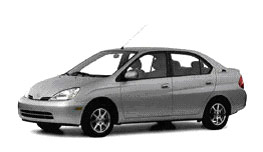 The second generation Toyota Prius (NHW11) has already been intended for sale around the world. Having left in 2000, the car was produced for three years. It is here that the mystery of the PRIUS numbering lies. Although the second generation was almost identical to the first, from a technological point of view it is completely different. There were so many changes that we can safely talk about Prius II. Almost the entire filling was processed. Both engines significantly added in power, the battery decreased, allowing the backs of the seats, other changes were made.
The second generation Toyota Prius (NHW11) has already been intended for sale around the world. Having left in 2000, the car was produced for three years. It is here that the mystery of the PRIUS numbering lies. Although the second generation was almost identical to the first, from a technological point of view it is completely different. There were so many changes that we can safely talk about Prius II. Almost the entire filling was processed. Both engines significantly added in power, the battery decreased, allowing the backs of the seats, other changes were made. 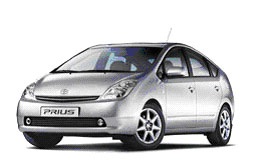
In 2003, the third generation of Toyota Prius (NHW20) saw the light. Now the car has stopped looking like an average Japanese sedan. A completely new design and seriously modified technologies made it possible to win the title of a car of the year 2005 in Europe. The Toyotovites themselves say that if the Prius II is comparable in its parameters (capabilities and speakers) with Toyota Avensis 1.8 Automatic, then Toyota Prius III is already a competitor to Toyota Camry 2.4 Automatic 2003 release.
Gleb Hoyt. Photo by the author
Source: Auto.mail.ru
Toyota Prius 2006 Crash Video - 2008
Toyota Prius 2006 test drives - 2008
Toyota Prius 2006 malfunctions - 2008
Toyota prius: Detailed information| Prius 2006 - 2008 | |
|---|---|
| Engine |  |
| Transmission |  |
| Control system and suspension |  |
| Brake system |  |
| Air heating and air conditioning |  |
| Launch and charging system |  |
| Electric components and so on |  |
| Corrosion body stability |




